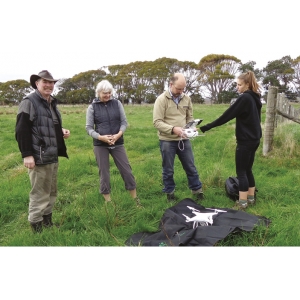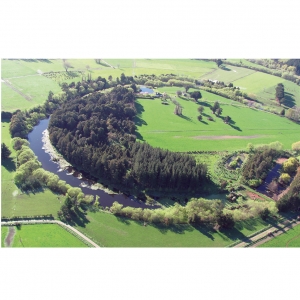Displaying items by tag: Ecosystems
Special treatment for Egmont National Park
Project Taranaki Mounga, a ten year $24 million project involving pest eradication and reintroduction of species over the 34,000ha of Egmont National Park was last December given the green light with a funding commitment by the NEXT Foundation.
Local philanthropic organisation the NEXT Foundation announced it would invest up to $15 million in the restoration of Taranaki’s native ecology. The Foundation has committed to funding Project Taranaki Mounga, a 10 year project involving pest eradication and reintroduction of species in Egmont National Park.
The venture between the NEXT, DOC, iwi, and the Taranaki community will begin with pest and weed control and the ecological restoration of Egmont National Park and a small number of volcanic peaks and offshore islands. NEXT and DOC have committed to funding the first phase of 18 months with strong interest from other parties. DOC has committed just over $1.6 million for the first phase.
Work will start on phase one this February and during the 18 months the project intends to:
- complete a goat eradication feasibility plan;
- develop a translocation strategy for black petrel; pateke, kaka, kakariki, takahe, kokako and short tailed bats;
- develop a pest reinvasion monitoring regime;
- extend the predator trapping network to protect birds particularly whio and kiwi.
- translocate North Island robin into the park.
DOC Director General Lou Sanson said he was thrilled Project Taranaki Mounga has been given a green light with the commitment of funding from the NEXT Foundation.
“Project Taranaki Mounga has been recognised as one of the next big exciting and bold conservation ventures,” said Lou Sanson.
The project’s vision is to protect our mountain for our wellbeing – Ko Taranaki tooku whakaruruhau.
“Given the strong Iwi connection and Whakapapa to Taranaki Mounga, Iwi are a critical partner in the successful delivery of this project.
Lou said the project will create a legacy of cultural, environmental and economic benefits for generations to come.
“Healthy flourishing ecosystems will sustain the quality and abundance of freshwater underpinning the Taranaki economy which adds to New Zealand’s image, and showcases this country’s leadership in pest eradication.
“It’s exciting knowing lessons learnt in Taranaki will be able to be transferred to even larger landscapes when successful,” said Lou.
Wairio in action
A busy day at Wairio:
There was a digger on site to raise the walking track.
The success of retaining water in the wetland has required this work. Also the need to clear a few culverts to allow the water to flow more easily from Stage 4 (in the slightly higher ground in the north of the wetland) to the Stage 3 area. Though there is still plenty of work in progress and the need to equalise the water level.
There is new walking track signage made by DOC. That will be a big help for those interested in exploring the area.
And lastly, Stephen Hartley from Victoria University (with helpers Maxine, Veronica and our own Ross Cottle) starting a drone flight to record vegetation and water levels, principally in the Stage 3 research area.
A unique New Zealand wetland enhancement project
In 2008 Taumata Lagoon, south east of Carterton in the Wairarapa Region of New Zealand, was classified as “A WETLAND OF NATIONAL IMPORTANCE”.
The lagoon is also recognised as the country’s best example of an “Oxbow Lagoon” – with both ends of the lagoon being only 300-metres apart.
In addition, the inner area of the lagoon contains between 200 and 250 ancient Totara and Kahikatea. (Possibly the most significant area of ancient forest on the floor of the Wairarapa valley).
The 34-hectare lagoon environment is also the home of over 40 different species of birds – including good numbers of the rare and endangered endemic NZ Dabchick, large numbers of NZ Shoveler, Grey Teal and Black Swan (there are now close to no mallards!), plus bush birds, including: Falcon, Kereru, Tui, Bellbird and huge numbers of Fantail.
In addition 110 different species of endemic plants have been identified in the area.
Taumata Lagoon
A wetland of national importance and a classic oxbox lagoon, with close to half of the lagoon and its environs being protected by a QEII National Trust Open Space Covenant.
The lagoon is 9 kilometres south east of Carterton – a rural town in the Wairarapa region of New Zealand.
Sylvia and Neil Hayes purchased part of Taumata Lagoon in 1990 and since then considerable enhancement of the environment has taken place, and, with lots of dedicated assistance, a weir to regulate water levels was constructed, well over 5000 willows have been removed, over 8000 Totara, Kahikatea and swamp flax have been planted and several thousand predators have been eliminated; with management of the predator control programme being carried out by the Greater Wellington Regional Council since 2000. The Timms trap was originally designed as a Possum trap, but has proven to be highly successful in the elimination of – feral cats, ferrets, stoats and hedgehogs. The largest ferret ever eliminated in New Zealand was in a Timms trap – at Tamata Lagoon.
Historically the most desirable lagoon water levels have relied heavily on flood water from the adjacent Waiohine River, but in 2014 a Waiohine River stop bank burst its banks – the result being that flood water pours through the gap and heads straight to the Ruamahanga River – instead of the lagoon!
The Waiohine and the Ruamahanga rivers converge three kilometres to the south of Taumata Lagoon and each river floods 3 to 4 times each year.
The Regional Council informed the four owners of Taumata Lagoon that they had no funds available to rebuild the stopbank – and the owner of the stopbank property said he didn’t want the stopbank rebuilt!
At my instigation, on September 14, 2016, a meeting was held on site to discuss how best the problem could be resolved. Involved were GWRC staff, the four lagoon owners, the Wairarapa QEII National Trust representative and the landowner of the stopbank area. With full support of all involved the outcome of the meeting was to reverse the flow of water through the adjacent neighbours flood drainage channel (which normally puts flood water back into the Waiohine River), construct a culvert under the road, construct a channel on the Hayes property and join it up with the culvert.
In 1942, in the same area, there were large numbers of endemic Totara (Podocarpus totara) and the endemic Kahikatea (Dacrycarpus dacrydioides), but all but seven of the Totara were milled during the 1950s.
This aerial photo was taken in 1942.
The area just above the gravel road at the bottom of the photo is where Suez #2 was created and where our final planting programme was completed in August 2017.
Many of the Totara and Kahikatea in the main part of the natural forest were also milled at the same time, but approximately 100 Totara and 250 Kahikatea survived and many of these have a QEII National Trust Open Space Covenant over them, which protects them and all plantings since 1990 in perpetuity. Most of the Totara and Kahikatea are ancient – with massive trucks!
Close to 50 different species of birds have been identified in the lagoon area and over 100 endemic trees and plants have
been identified.
The Hayes block of land where the “Suez #2” was created was leased to a neighbour for 10 years, but as soon as the lease expired Neil and Sylvia Hayes commenced another major native planting programme – initially with native swamp flax (for shelter belts) and then Totara.
Between 1990 and 2017 Neil and Sylvia have proven the ancient Greek proverb to be wrong: “THE WORLD GROWS BETTER WHEN OLD PEOPLE PLANT TREES KNOWING THAT THEY WILL NEVER SIT IN THEIR SHADE.”
All finished five days later – with grass seed spread throughout the flat ground. The flow of water from the neighbours drain was reversed – and instead of the water flowing back into the Waiohine River it now flows into Taumata Lagoon.
NZ Swamp Flax grows rapidly and provides an excellent wind break for other endemic plants and trees – and for the endemic Tui (Prosthemadera novaeseelandiae), Bellbird (Anthornis melanura) and the native Fantail (Rhipidura). The NZ Native flax provides an array of insects and nectar.
The first flow through the canal and into the lagoon was in April 2017.
Summary
A superb outcome to a complex wetland management problem.
Sincere thanks to the GWRCs Masterton Branch; the GWRC Head Office, all five landowners involved, particularly the adjacent neighbours – the Herrick Family – for their essential support with the use of their drain and the QEII National Trust for their support.
If further information is required please contact Neil Hayes on (06) 3796692 or by Email on This email address is being protected from spambots. You need JavaScript enabled to view it. – or at PO Box 188, CARTERTON.
Neil Hayes
QSM CEnv DU (NZ) Foundation Member & DU (NZ)
Life Member.




